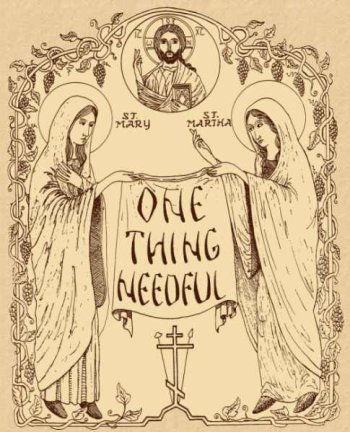
ONE THING NEEDFUL
SUMMER 2014
Now it happened as they went that He entered a certain village; and a certain woman named Martha welcomed Him into her house. And she had a sister called Mary, who also sat at Jesus’ feet and heard His word. But Martha was distracted with much serving, and she approached Him and said, “Lord, do You not care that my sister has left me to serve alone? Therefore tell her to help me.” And Jesus answered and said to her, “Martha, Martha, you are worried and troubled about many things. But one thing is needed, and Mary has chosen that good part, which will not be taken away from her.” — Luke 10:38-42
The liturgical year has begun again and the first of our major feasts, the Nativity of the Theotokos is celebrated. In the gospel for the liturgy of the feasts of the Theotokos we hear the familiar story of Martha’s request of Jesus for her sister Mary’s help and receives “Mary has chosen the good part . . .”
How often can Jesus say to us “ . . . you are worried and troubled about many things. But one thing is needed . . .”? Oh, if it could be so easy to follow Mary’s example and sit at Jesus’ feet, but our lives are not designed that way. We need to find the balance – for it is mandatory for us to serve as well as listen to the Lord.
The key is in the how we serve. Each moment can be filled with joy remembering God is in the moment. He loves us so much. He wants us to trust in Him, not worry about things. He is in full control of our world no matter the appearance.
So let us gratefully accept our responsibilities to serve as He wishes with His gift of peace and consciously seek the quiet awareness of His presence in the moment that He may say to us, “Blessed are you who hear the word of God and keep it.” (Luke 11:28)

MONASTERY NEWS
A BIG THANK YOU TO ALL OF YOU
WHO DONATED BRICK MONEY.
WE NOW HAVE ENOUGH TO BRICK
IN THIS THIRD OF THE BUILDING.
Earlier in the summer, the framers installed the fascias. Later vinyl workmen came and added the soffits and exterior ceiling of the outside stairwell. Then work came to a halt while we raised the funds to brick in this section of the building.
Many of you responded with contributions to our brick campaign. It all added up and up until we reached our goal. Thank you.
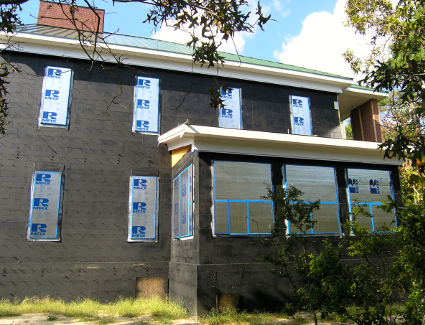
Over the last two weeks, we have watched with fascination as the building transformed from the grey of concrete blocks to pitch black after being sprayed with a tar-like substance. Currently, the building has taken on a silver and blue coloring as the foam board is being applied. This process is called damp-proofing. At first it seemed like he was taking an inordinate amount of time, till we learned that all the loose mortar had to be removed from the block before he could spray on the tar base. Knowing what it takes to clean a small, but filthy floor, our hearts went out to him.
After checking the numbers several times to make absolutely sure that we had the money to brick in the building, we emailed our contractor with the good news. He, in turn, welcomed the news and ordered the brick. Then the brick company informed him that it would be eight weeks before they could deliver them. We all know what “hurry and wait” is all about.
On September 15th and 16th, we received two loads of brick. Many more will follow, including cove bricks (a concave brick used in edging) and ogee bricks (an S shaped brick used for window sills). Maybe, just maybe, the building will be bricked in by the New Year.


After this, and as we have the where with all, an exterior stairway, like the kind you see at motels, will be built. Then we can begin to work earnestly on the interior of the chapel. While it seems slow, we know that everything happens in God’s time.
In mid-June, we hosted a harp teacher and three of her students who were on their way to New Orleans to attend the National Conference of the American Harp Society. They were members of the Crane Harp Ensemble which was one of three harp ensembles to be chosen to play at this event.
Due to all that is put before us, it was June 21st before we went to the Barnyard Flea Market. We were grateful to make $304.95 for the building fund.
This year the Diocesan Assembly for The Diocesan of the South was held in Dallas, Texas. Try as she might, Mother Thecla, who lived there for over twenty years, can never get around to visiting everyone, and we’re all aging fast. Overall, it was a good assembly.
While Mother Thecla was in Texas, Mother Helena and Sister Marina manned our booth at the Midlands Homeschool Convention (MHC) in Columbia, South Carolina for two and a half days. With over five hundred people in attendance, we were able to be a witness to the Orthodox Faith and introduce people to monasticism and our monastery. This convention was managed by Orthodox Christians from the Alliance Homeschool Accountability Association (AHAA) in South Carolina.
It has become a tradition for a group of girls with their chaperons from the Exaltation of the Holy Cross Orthodox Mission in High Point, North Carolina, to visit us each summer before school begins and to help us with different projects around the monastery. This year they helped with raking, weeding, planting, and mulching around the ramp area and the front of our doublewide, and other outdoor tasks. All in all, we were blessed by their presence and enjoyed getting to know and work with them.
Saturday Liturgies have been well attended of late. Of special note was the Liturgy served here on September 13th. The 2014 Liturgies were schedule in September of the previous year. Last year at this time, Holy Resurrection Orthodox Mission was struggling to purchase some land with buildings which they eventually accomplished. Realizing that they probably wouldn’t have a permanent priest by September of this year and that the 13th, their feastday, fell on a Saturday, we scheduled Liturgy here that day. “O ye of little faith,” — a priest and his family showed interest in this little mission in North Augusta, South Carolina. While filling in for another priest in the area while he is on sabbatical, the parishioners have had the opportunity to build a relationship with Fr. Alexis Baldwin and his family, and he with them. The parishioners took a “leap of faith”, renovated the 1400 square foot garage for their chapel and will be moving into it so that Fr. Alexis and his family can live in the house soon. Being their feastday, the Commemoration of the Dedication of the Church of the Holy Resurrection of Christ our God in Jerusalem, an event that took place on September 13, 335, Liturgy was served here. Next year, God willing, they will celebrate their feastday there.
As the monastery becomes more established, there are more burials here. This quarter has seen three:
August 9th — Andrew John Urzan, a dear friend of the monastery
September 9th — Silas Hays, a child, of Saint Justin the Martyr Church, Jacksonville, Florida
We are constantly being reminded that all of us are in need of healing, and there is much suffering that is inflicted on our Christian brethren throughout the world. Pray fervently for them and our enemies.
Two Wonderworking Unmercenaries,
Martyr-Saints Cyrus & John &
Martyrs Athanasia &
Her Three Daughters,
Theoktiste, Theodote & Eudoxia
(January 31st)
What is a “wonderworking unmercenary” or, as one would say in transliterated Greek, “thaumatourgoi anargyroi”? The first word, “thaumatourgoi”, denotes someone who works miracles (a wonderworker), and the second, “anargyroi”, means “without silver” (unmercenary). Many of the doctor saints in the Orthodox Faith, who, healed people of divers ailments and did not charge for their services, were spiritual and prayerful Christians who received the gift of healing from the Holy Spirit and cured many in the name of Jesus the Christ or by simply making the sign of the cross over the patient. Cyrus and John are two such wonderworking unmercenaries who also suffered martyrdom along with Anastasia and her three daughters.
In mid-third century Alexandria, Egypt, Cyrus (Kyros or Abakir) was born to Christian parents who brought him up in the Christian faith and provided him with an excellent education which culminated with his being trained as a physician at the University of Alexandria. Cyrus, who healed both people and animals, became known for his compassion as well as his gift of healing. Knowing that his house was a haven for the sick and the poor, many Alexandrians, who admired and loved him, built a small infirmary in the courtyard of his home.
Always, Cyrus sought to heal souls as well as bodies. He would share the Gospel of Christ with everyone and heal in the name of Christ the Savior. Those whom he cured, he would instruct, saying, “Whosoever would not become ill, let him abstain from committing sin; as ofttimes sickness is the result of sin.” Thus, there were many converts to Christ, the Christian faithful were strengthened, and the Church in Alexandria grew.
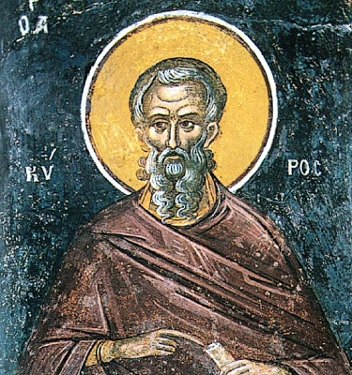
Being well known as a Christian healer, some pagans obtained an audience with the prefect of Alexandria, a ruthless and merciless man, and denounced Cyrus as a Christian. When summoned to appear before the prefect, Cyrus fled to Arabia and entered a monastery near the Persian Gulf where he became a monk. There he fasted and prayed more intensely and cured many by simply making the sign of the cross. Again, he became renowned as a wonderworking unmercenary.
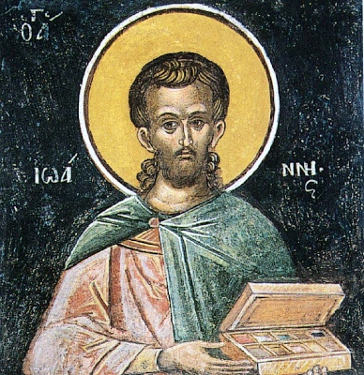
John, whom iconographers portrayed as being younger than Cyrus, was born and raised in Edessa, Mesopotamia (currently Urfa, Syria). John, secretly being a pious Christian, served as a medicus (doctor) of high rank in Diocletian’s (284-305) army. Upon hearing that Diocletian, at Galerius’ (305-311) urging, had given orders to resume the persecution of Christians and on learning of the numerous miracles wrought by Cyrus, John left the army to seek out this physician named Cyrus. John first journeyed to Jerusalem where he fulfilled a vow he had made. From there, he traveled to Alexandria only to be informed that Cyrus was in a monastery in Arabia. Eventually John found Cyrus, joined him in the monastic life, emulated his ascetic struggles, and became a wonderworking unmercenary as well.
Cyrus and John walked throughout Arabia and Egypt, teaching the Gospel, healing many of their infirmities, and encouraging many to endure martyrdom courageously. All the while, the persecution of Christians intensified.
In January of 311, Cyrus and John heard of a woman and her three daughters: Athanasia (a name meaning immortal), Theoktiste (love of God), Theodote (gift of God), and Eudoxia (glory of God), ages 15, 13, and 11 respectively. They had been arrested at Canopus, brought to Alexandria, and imprisoned because they were Christians. Knowing that they were in the hands of Syrianus, a heartless and cruel high-ranking government official of Alexandria, who vehemently enforced Galerius’ edict to wipe out all Christians, Cyrus and John hasten to find them. They firmly believed that, under torture, the mother and three children would easily weaken and deny Christ rather than remain steadfast to the end.
Reaching Alexandria, they found the prison where Athanasia, and her daughters were being held, made their way in, and were exhorting them to remain unfalteringly faithful to Christ. Some nonbelievers reported Cyrus and John’s activities to Syrianus who, in turn, commanded that they be found and brought before him. Syrianus proffered them the opportunity to avoid torture and death if they would recant their faith in Christ and offer sacrifice to the Roman gods. Cyrus and John utterly rejected Syrianus’ proposal. Whereupon, Syrianus ordered Athanasia, Theoktiste, Theodote, and Eudoxia to be dragged from their prison cell, forced to watch Cyrus and John suffer grievous torments, and threatened with the same if they did not deny their faith in Christ.
First Cyrus and John were flogged mercilessly. Then parts of their bodies were crushed and burned. After pouring vinegar and salt all over them, their flesh was abraded with devilishly coarse fabric, and, afterwards, boiling tar was poured on their legs. Some of those who witnessed their torments and steadfastness of faith in Christ became Christians. Much to Syrianus’ displeasure, Athanasia and her daughters remained unwavering, thus provoking him to order the torturers to scourge them with all their strength. Observing their perseverance, Syrianus commanded that they be beheaded. One by one, each young maiden and their mother gladly submitted to the block, thereby earning a martyr’s crown and their eternal reward with Christ.
Turning to Cyrus and John, Syrianus attempted to persuade them to recant their faith with flattery and promises of riches along with a good life, only to be repudiated. Flaring with anger, he flung threats at them, but to no avail. Like Athanasia and her three daughters, Cyrus and John were beheaded, won the race, and gained their rewards. Their martyrdom took place on January 31, 311.
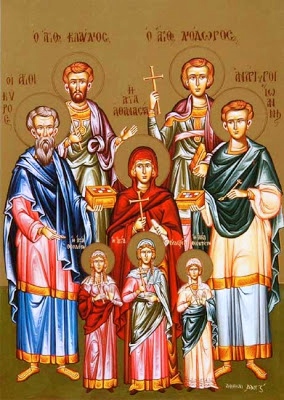
Back Row: Martyrs Claudios & Diodoros
Center Row: Martyrs Cyrus, Athansia & John
Center Front: Theodote, Theoktiste & Eudoxia
Not being satisfied with all that he had done to these six martyrs, Syrianus gave instructions for their bodies and heads to be carried to a place where wild beast and carrion birds could eat them. Nonetheless, some pious Christians secretly recovered their bodies and buried them in the Church of Saint Mark the Evangelist in Alexandria.
NOTE: Much of what we know of their lives is recorded by Saint Symeon the Metaphrastes (d. 960) who researched and wrote about more than seven hundred saints.
Around 400 A.D. when Arkadios was emperor of Byzantium (395-408) and Theophilos was Patriarch of Alexandria (384/385-412), a search was made for the relics of Saints Cyrus and John. With prayers being offered up requesting divine guidance, the relics were found. When the tomb of the Unmercenaries, Cyrus and John, was opened, a sweet-smelling fragrance emitted from their almost incorrupt bodies. A profusion of miracles followed in the wake of their unearthing.
Patriarch Theophilos, desired to rid Menouthis (present day Abu Qir), a town fourteen miles northeast of Alexandria, of the many demons that haunted that place and to lessen the influence of the Isis cult there, as Menouthis was one of the most important healing centers of his day. In addition, the patriarch knew that some Christians were also seeking healing at this Temple to Isis. The Patriarch had a small church dedicated to the Holy Evangelists built near Menouthis and sent monks to pray the divine offices therein. However, Patriarch Theophilos died before the relics of the two healers could be transferred and was succeeded by Saint Cyril of Alexandria (412-444). Shortly thereafter, an angel appeared to Patriarch Cyril in a vision and instructed him to transfer the relics to Menouthis.
On June 28, 412(414), all was ready. Their relics were reverently placed on a wagon. A sumptuous procession of clergy and lay people followed behind, chanting prayers, bearing lamps, and burning incense. It is said that the whole city of Alexandria turned out for this great event. As they walked the fourteen miles to the Church of the Holy Evangelists, a multitude of healings occurred. Demons were cast out. Some of Isis’ priests approached Patriarch Cyril and respectfully requested baptism. The influence of those who served the goddess, Isis, was greatly diminished.
Saint Cyril of Alexandria had a much larger church built in Menouthis in honor of Saints Cyrus and John and transferred their relics there. Pilgrims with diverse infirmities journeyed to this shrine seeking healing. With great hope and faith along with a profusion of prayers that they would be cured, they were anointed with oil from the lamps that burned there, partook of holy water from the fountain in the courtyard, and slept in the sanctuary to be near the martyrs’ relics in the expectation that the saints would appear to them and that they would be healed (a practice known as incubation).
In time, Patriarch Cyril destroyed the temple to Isis. Later, Archimandrite Shenoute the Great (c. 347-466) expunged any remnants of the Isis cult that remained in Menouthis.
An interesting account was written about Apollinarios the Great (551-568), the Greek Orthodox Patriarch of Alexandria, who had a church built over the site of Saint Cyrus’ infirmary and dedicated it to the Three Holy Children (Ananiah, Mishael and Azariah, or, Shadrach, Meshach, and Abednego).
“Apollinarios sent a certain virtuous hegumen (the head of a monastery) to Babylon, giving him a letter in which the patriarch petitioned and entreated the holy Three Children to consent to his taking a portion of their sacred relics and depositing them in the church he had erected in Alexandria. He held these saints in great veneration; having faith in them, he wrote the letter as if they were still physically alive and would read it themselves.
The pious hegumen departed with all dispatch for Babylon. (Alexandria to Babylon is about 1340 miles, one way.) Once there, he knelt down before the holy relics. With faith and tears, he besought the three holy youths to accept the epistle and grant the request written by the devout patriarch. Then the saint in the middle arose -- O frightful event of divine economy! -- and extended his hand to take the letter. Thereupon the saint, without speaking a word, lay down again. The hegumen marveled at this wondrous sight, but he also was sad; for he failed to achieve that which he requested. He remained in the church, praying throughout the entire week. After seeing that the saints offered no further response, he returned to the patriarch sorrowing and bringing back tears instead of relics. But the latter sent him back again, saying. “Go thou a second time and entreat the saints with yet greater fervor. Do thou trust in God that thou wilt not return disappointed. If again, they do not give thee anything, bring back the letter which was sanctified by them; and I will keep it as a consolation.” The good hegumen, humble and obedient, then traveled to Babylon with great difficulty and effort. He made supplications before the saints with tears, imploring them to have pity upon his exertion and condescend to the patriarch’s pious request.
He prayed thus for many days, though he did not see any result at all. Therefore, despairing of achieving his desire, he leaned over in order to take the letter, even as he had been ordered. Now as he withdrew it -- O the wonder! -- the saint’s hand holding the letter detached from the body, The hegumen took the sacred relic in his hand, rejoicing; for his former grief had been transformed into joy. Upon his arrival in Alexandria, a great celebration was held by the faithful. There was great jubilation as the archbishop consecrated the holy church, placing the letter to the right of the sacred hand and giving thanks to the Lord.”— (Excerpt from The Great Synaxaristes of the Orthodox Church, January, pgs. 1168-1169)
Patriarch Sophronius I of Jerusalem (634-638) (formerly Sophronius the Sophist) personally received healing from Cyrus and John. Being a man of letters and an avid reader, he was going blind due to eye strain from over-study. Fervently imploring the saints to heal his eyes, they appeared to him. Cyrus made the sign of the cross over one eye and John kissed the other eye, thus restoring his sight completely. The unmercenary wonderworkers asked Sophronius to record some of their miracles. With immense gratitude, he chronicled seventy of their miracles (c. 610) and composed an encomium (a speech/writing of praise) to Cyrus and John.
While there is a plethora of miracles to report and documentation of various shrines where their relics reside, space confines us. As God wills, they continue to work healings in this world.
Coptic Synaxarium Vol. II, (pgs. 310-311) St. George Coptic Orthodox Church, Chicago, Illinois, 2000
The Great Synaxaristes of the Orthodox Church, January (pgs. 1167-1172) & July (pgs. 783-786), Holy Apostles Convent, Buena Vista, Colorado, 2003
Holy Unmercenary Doctors: The Saints Anarguroi Physicians & Healers of the Orthodox Church, by Georgia Hronas, Light & Life Publishing, Minneapolis, Minnesota, 1999
http://amphilochios.blogspot.com/2011/06/discovery-of-relics-of-sts-cyrus-and.html Orthodox Life 27/06/2011

BUILDING FUND UPDATE
Thanks be to God. So many of you responded by sending money for bricks that we have more than enough to damp-proof and then brick in the three sides of this third. Thank you! Thank you! Thank you!
Our next challenge is purchasing and installing the exterior stairwell so we can more easily access the second floor. Then we will begin work on the interior, God willing.
Saints Mary & Martha Orthodox Monastery
65 Spinner Lane
Wagener, South Carolina 29164
For pictures and updates on the “Building of Our Monastery”, you can now go to
http://www.saintsmaryandmarthaorthodoxmonastery.org/buildingplans.html



Saturday Liturgy Schedule
October 4th at 9am
November 1st at 9 am
December 13th at 9am
January 10th at 9am
February 14th at 9am
Matins starts at 8 am.

FROM MARTHA’S KITCHEN
Maria's Salad with a Twist
1 large orange bell pepper, chopped
2 cups of cooked corn off the cob
OR 2 cups frozen corn cooked
1 medium white onion, chopped
1 large red tomato, chopped
2 heads of Romain lettuce, torn into pieces
1 Hass avocado, peeled, seeded, & chopped
½ cup cilantro leaves (optional)
1 jalapeño, seeded and sliced very thinly (optional)
chopped pieces of cooked chicken or salmon (optional)
Toss ingredients together and serve with salad dressing of choice.
Salad Dressing Ideas
For a light salad dressing, combine the following and toss into salad.
¼ cup total of sesame and/or olive oil
pepper to taste
juice from ½ of a lemon
For a heavier dressing use a chunky blue cheese dressing on non-fast days or Vidalia onion dressing on fast days.
Recipe by Maria Tercero
NOTE: This recipe is a cool, refreshing way to make a meal-in-one.